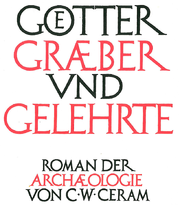
Gods, Graves and Scholars: the Story of Archaeology
Encyclopedia

C. W. Ceram
C. W. Ceram was the pseudonym of German journalist and author Kurt Wilhelm Marek, known for his popular works about archaeology. He chose to write under a pseudonym to distance himself from his earlier work as a propagandist for the Third Reich.Ceram was born in Berlin. During World War II, he...
about the history of archaeology
Archaeology
Archaeology, or archeology , is the study of human society, primarily through the recovery and analysis of the material culture and environmental data that they have left behind, which includes artifacts, architecture, biofacts and cultural landscapes...
. First published in 1949, Ceram's book introduced the general reading public to the origin and development of archaeology. It sold extremely well — over 5 million copies have been published in several languages — and remains in print today.
Gods, Graves, and Scholars covers Greek
Ancient Greece
Ancient Greece is a civilization belonging to a period of Greek history that lasted from the Archaic period of the 8th to 6th centuries BC to the end of antiquity. Immediately following this period was the beginning of the Early Middle Ages and the Byzantine era. Included in Ancient Greece is the...
, Egyptian
Ancient Egypt
Ancient Egypt was an ancient civilization of Northeastern Africa, concentrated along the lower reaches of the Nile River in what is now the modern country of Egypt. Egyptian civilization coalesced around 3150 BC with the political unification of Upper and Lower Egypt under the first pharaoh...
, Mesopotamia
Mesopotamia
Mesopotamia is a toponym for the area of the Tigris–Euphrates river system, largely corresponding to modern-day Iraq, northeastern Syria, southeastern Turkey and southwestern Iran.Widely considered to be the cradle of civilization, Bronze Age Mesopotamia included Sumer and the...
n, as well as Mexican
Mexico
The United Mexican States , commonly known as Mexico , is a federal constitutional republic in North America. It is bordered on the north by the United States; on the south and west by the Pacific Ocean; on the southeast by Guatemala, Belize, and the Caribbean Sea; and on the east by the Gulf of...
, Central America
Central America
Central America is the central geographic region of the Americas. It is the southernmost, isthmian portion of the North American continent, which connects with South America on the southeast. When considered part of the unified continental model, it is considered a subcontinent...
n, and South America
South America
South America is a continent situated in the Western Hemisphere, mostly in the Southern Hemisphere, with a relatively small portion in the Northern Hemisphere. The continent is also considered a subcontinent of the Americas. It is bordered on the west by the Pacific Ocean and on the north and east...
n archaeology. It gives brief, informative biographies of archaeologists like Heinrich Schliemann
Heinrich Schliemann
Heinrich Schliemann was a German businessman and amateur archaeologist, and an advocate of the historical reality of places mentioned in the works of Homer. Schliemann was an archaeological excavator of Troy, along with the Mycenaean sites Mycenae and Tiryns...
, Jean-François Champollion
Jean-François Champollion
Jean-François Champollion was a French classical scholar, philologist and orientalist, decipherer of the Egyptian hieroglyphs....
, Paul-Émile Botta
Paul-Émile Botta
Paul-Émile Botta was a French scientist who served as Consul in Mosul from 1842.-Life:...
, and Howard Carter
Howard Carter (archaeologist)
Howard Carter was an English archaeologist and Egyptologist, noted as a primary discoverer of the tomb of Tutankhamun.-Beginning of career:...
, among others.

